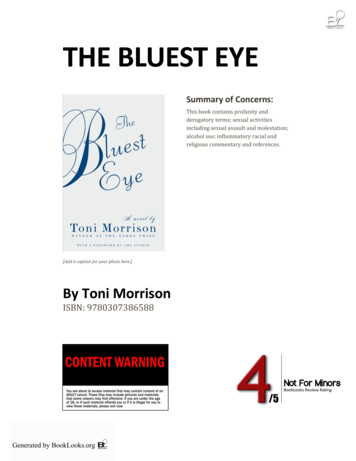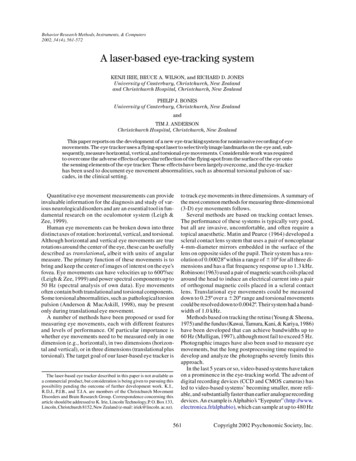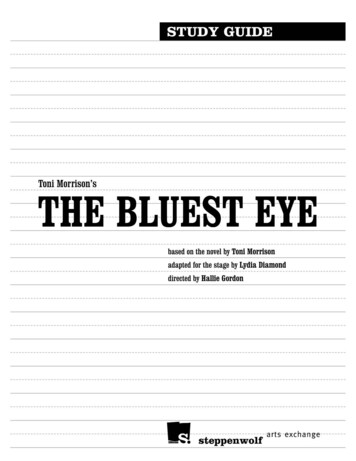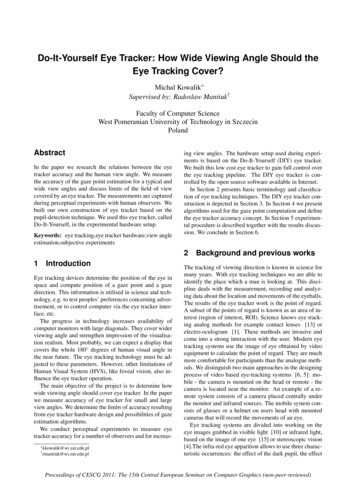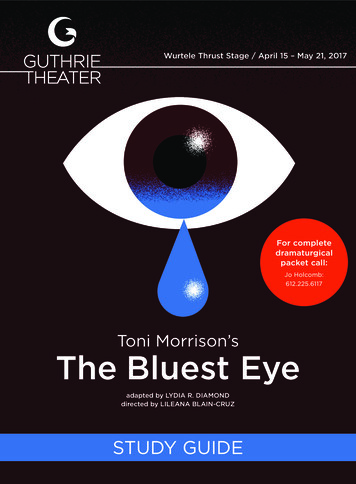
Transcription
Wurtele Thrust Stage / April 15 – May 21, 2017For completedramaturgicalpacket call:Jo Holcomb:612.225.6117adapted by LYDIA R. DIAMONDdirected by LILEANA BLAIN-CRUZSTUDY GUIDE
InsideTHE PLAYSynopsis 3The Characters 3,4THE AUTHORAbout the Adaptor 5About the Author 7In the Authors’ Words 9CULTURAL CONTEXTSetting: Lorain, Ohio 10THE GUTHRIE PRODUCTIONNotes from the Creative Team 15ADDITIONAL INFORMATIONFor Further Understanding 17For complete dramaturgical packet call:Jo Holcomb: 612.225.6117Carla Steen: 612.225.6118Play guides are made possible byGuthrie Theater Study GuideCopyright 2017DRAMATURG Jo HolcombGRAPHIC DESIGNER Akemi GravesRESEARCH Jo Holcomb and Amy SlothowerGuthrie Theater, 818 South 2nd Street, Minneapolis, MN 55415ADMINISTRATION 612.225.6000BOX OFFICE 612.377.2224 or 1.877.44.STAGE TOLL-FREEguthrietheater.org Joseph Haj, artistic directorThe Guthrie Theater, founded in 1963, is an American center for theater performance,production, education and professional training. By presenting both classical literature andnew work from diverse cultures, the Guthrie illuminates the common humanity connectingMinnesota to the peoples of the world.2 \ GUTHRIE THEATERAll rights reserved. With the exception of classroom use by teachers andindividual personal use, no part of this Play Guide may be reproducedin any form or by any means, electronic or mechanical, includingphotocopying or recording, or by an information storage and retrievalsystem, without permission in writing from the publishers. Some materialspublished herein are written especially for our Guide. Others are reprintedby permission of their publishers.The Guthrie Theater receives support from the National Endowmentfor the Arts. This activity is made possible in part by the MinnesotaState Arts Board, through an appropriation by the Minnesota StateLegislature. The Minnesota State Arts Board received additional funds tosupport this activity from the National Endowment for the Arts.
THE PLAYBrittany Bellizeare as PecolaPHOTO: LAUREN MUELLERSynopsisThe CharactersThe Bluest Eye tells the story ofone year in the life of a youngblack girl in 1940s Lorain,Ohio. Eleven-year-old PecolaBreedlove wants nothing morethan to be loved by her familyand schoolmates. Left to fendfor herself, she blames herdark skin and prays for blueeyes, sure that love will follow.The events of The Bluest Eyetake place primarily from theAutumn of 1940 to the sametime in 1941, but in order toexplain the full stories behindthose events, the narrativefrequently moves back in time.Claudia MacTeer is the younger oftwo sisters in the MacTeer family.She contributes two “voices”to the story — one as a child,one as an adult — with curiosity,compassion and perspective,which she uses to reflect on thefate of her childhood friend,Pecola.Frieda MacTeer is the older of thesisters, less adventuresome andwitty than Claudia and, in someways, dependent on her sister forjudgment, despite her reserves ofgeneral, practical information.Pecola Breedlove is the “littlegirl-gone-to-woman” in the story.She shares her family’s convictionthat she is ugly and unworthy butsomehow has sufficient resolve toattempt a few self-help strategies.Of all the characters, Pecolahas been most damaged by hercircumstances in life, beginningwith having a family incapable ofnormal expressions of love andprotection. Nearly every event inher life leaves her a victim, and thestory examines what influencesled to her fate and what influenceskept her from being helped.GUTHRIE THEATER \ 3
THE PLAYMrs. MacTeer/Mama is too busymaintaining a household on meagerresources to hover affectionatelyover her children, but her love forClaudia and Frieda is evident in thework she does to keep the familynourished, healthy and together.Mr. MacTeer has little verbalpresence in his household, buthe works hard to keep the familygoing and is fiercely protective ofhis children when it is necessary.Mr. Yacobowski, as a memberof the immigrant working class,has also been marginalized bymainstream society, but as awhite male, he is “allowed” to feelsuperior to a little black girl. Hisinteraction with Pecola supplies thenarrative with a vignette portrayingthe dynamics of class division inAmerican society.Mrs. Breedlove/Pauline, originallyfrom the South, fails to findcommunity, intimacy or sustainingwork in Ohio. She falls underthe spell of lifestyle and beautystandards that shecannot achieve and consequentlydrifts into resentment, selfrighteousness and greaterisolation. Cut off from any sourceof emotional self-nourishment, sheis unable to nurture her children.Her daughter, Pecola, calls her Mrs.Breedlove.Mr. Breedlove/Cholly, Pauline’shusband and Pecola’s father, knewnothing about his father and wasabandoned by his mother at fourdays of age. He is, nonetheless,vigorous, sensual and spirited —perhaps because he was rescuedand raised by Aunt Jimmy and herwarmhearted female friends — andhas no trouble calling attention tohimself once he leaves home afterhis aunt’s death and enters theworld.4 \ GUTHRIE THEATERAunt Jimmy is Cholly’s aunt,who rescues him at the age offour days from the train tracks.She is a woman of great energyand warmth and, as a result, issurrounded by a bevy of olderfemale friends who heap affectionand concern onto Cholly. Whenshe becomes ill and dies, Cholly isoverwhelmed with feelings of lossbut has no means of expressingthem. Although Aunt Jimmy’sfriends would have stepped in totake charge of him, Cholly, with noimmediate family members left,flees.Soaphead Church/Elihue MicahWhitcomb His name Soapheadrefers to the particular appearanceof his hair—tight and curly that held“a sheen and wave when pomadedwith soap lather.” Soaphead’s chiefattribute is his fastidiousness,which creates the necessity for apristine and lifeless “life.” He useshis “special powers” to grant Pecolaher wish for blue eyes.
THE AUTHORSwas Vera in Agatha Christie’sTen Little Indians. Although thecharacter is involved in a romance,she recalls, “They wouldn’t let uskiss at the end because I was black.I was the only black kid doingtheatre.” Diamond graduated tobeing virtually the only AfricanAmerican college student doingtheater at Northwestern. Her aimwas to be an actor — she spent 10years identifying herself as one,while waiting tables, teaching andwriting: “I was writing plays longbefore I thought of myself as aplaywright.”She wrote her first adult play for anundergraduate course, and decidedin 1992 to produce it herself inthe basement of a vegetarianrestaurant in Chicago called CafeVoltaire, where she also workedas a cook. Diamond created herown theater company to do so,and called it Another Small BlackTheatre Company With GoodThings to Say and a Lot of NerveProductions.About the AdaptorLydia Diamond was born LydiaGartin in Detroit, Michigan in April1969. She began seeing Broadwayshows at around age eight —touring productions presented inthe University of MassachusettsFine Arts Center that her mothermanaged. “I grew up with nomoney, lots and lots of booksand a single mother with a Ph.D.”The first “grown-up play” she sawat her mother’s theater was TheElephant Man. “The audience wasdisturbed that I was there, becauseI was so young.” (American TheatreMagazine, December, 2011)As a child, Diamond studied violinand piano, met famous artiststhrough her mother, and neverlived anywhere longer than a fewyears, as her mother pursuedher academic career in Detroit,Carbondale, Ill.; Itta Bena, Miss.;Amherst, Mass.; and Waco, Tex.The only geographical constantcame during summers, which shespent with her grandparents, botheducators, in the little town ofSparta, Ill.Diamond’s high school in Waco had“a pretty decent theatre program,”and among the parts she playedHer husband, sociologist JohnDiamond, saw one of her earlyplays and was, in his words, “Blownaway. She grappled with theissues of race, class, sexuality andmarginality that are infused in allof her work but, because it wasessentially a one-woman show andsomewhat autobiographical, it wasvery personal. I felt like I knew her alot better.”Diamond’s subjects have varied,but her work generally alternatesbetween black history playsand contemporary dramas withautobiographical elements that usehumor to sweeten a sometimesdark exploration of familyrelationships, race, gender andclass.GUTHRIE THEATER \ 5
THE AUTHORSWhy I Had to AdaptThe Bluest Eyeby Lydia R. DiamondAdaptorIn high school I was given Toni Morrison’s Belovedas a gift from my English teacher, who had pickedme out as someone she wanted to mentor. I readit, but it went over my head. I think I was so youngthat I just shut down in places where it was hurtfulor too close to the truth.When I got to college, I realizedthat I wasn’t being given the canonof African American writers in myliterature classes or in the theaterdepartment, so I went looking forthem myself. I made it my missionto go out and get every one of ToniMorrison’s books and read them.I knew that she was a genius andthat she spoke to my soul, evenif I didn’t understand it all. WhenI read The Bluest Eye, I still had astrange response. The themes weretoo close to me or too painful. Ideluded myself into thinking itwas because it was beyond me.The writing was piercing, and itwas easier to tell myself, “I don’tunderstand.”But it’s very simple. The BluestEye is the story of a young AfricanAmerican girl and her familywho are affected by a dominantAmerican culture that says tothem: “You’re not beautiful; you’renot relevant; you’re invisible; youdon’t even count.” There is pain inthe novel – the way in which ourcountry has dealt with race, theway in which the power structurehas hurt us, and the way in which ithas made us hurt ourselves. Oftenenough we African Americans don’t6 \ GUTHRIE THEATERget the opportunity to say, “Thisis the source of my dysfunction,and it’s not all my fault.” To beshown that when you are youngis painful, horrible. On the otherhand, it’s affirming to have all thesethings made clear; things that Iknew were sick and wrong, thingsthat touched me in intangibleways, were all made clear just byhaving the lives of people like merepresented in literature.Morrison’s writing is elegant andpurposeful, never didactic orthematic. It’s from the soul. WhenI’m teaching, I tell my students thatwhen you’re writing from your soulabout what you know, it’s alwaysgoing to be political and relevant.So The Bluest Eye is not aboutrace, but it’s about the world ofthe characters, and unfortunatelyand fortunately they live in a placethat’s all about race.The call to write this adaptationfor Steppenwolf Theatre came in2005, days after I’d had my firstbaby. Actually, that coincidencemade it feel so very relevant tomy life. I thought, “All right! I’ma mother, and this book is morerelevant to my life than ever; butI’m also a playwright, and peoplestill know that I’m a playwright.” Ineeded that affirmation at exactlythat time.So I said “yes” without thinking,and then I thought, “Oh my God,did I just say yes to this enormousproject?” I started reading thebook again while I was holdingmy baby.Entire sections I had read manytimes before suddenly made moresense, were more personal. Therewere moments that resonated, likewhen Frieda and Claudia, towardsthe end of the novel, talk abouta newborn boy; they talk aboutthe little circles of “O” in his hair. Iwas reading about this little brownbaby that these characters werepraying would survive, and I washolding my own little boy, and thetext was just heartbreaking. Mylittle baby had circles of “O” in hishair, too. And right then I realizedthat I was adapting The Bluest Eyefor Baylor, my son, and it was themost empowering and frighteningand wonderful thing.This essay first appeared in Steppenwolf Theatre’sStudy Guide for The Bluest Eye. It is reprintedhere with their and Ms. Diamond’s permission andgenerosity.
THE AUTHORSAbout the AuthorRaised in the North, Toni Morrison’ssouthern roots were deliberatelysevered by both her maternaland paternal grandparents.Her maternal grandfather, JohnSolomon Willis, had his inheritedAlabama farm swindled from himby a predatory white man; as aconsequence of this injustice,he moved his family first toKentucky, where a less overt racismcontinued to make life intolerable,and then to Lorain, Ohio, a midwestern industrial center withemployment possibilities thatdrew large numbers of migratingsouthern blacks. Morrison’spaternal grandparents also lefttheir Georgia home in reactionto the hostile, racist culture thatincluded lynchings and otheroppressive acts. As a result, theSouth as a region did not exist as abenevolent inherited resource forMorrison while she was growing up;it became more of an estrangedsection of the country from whichshe had been helped to flee. Asis evident in her novels, Morrisonreturned by a spiritually circuitousroute to the strong southerntraditions that would again bereinvigorated and re-experiencedas life sustaining.The future Nobel literature laureatewas born Chloe Ardelia Wofford athome in Lorain, Ohio, on February18, 1931, the second child anddaughter to George and Ella RamahWillis Wofford. Two distinguishingexperiences in her early years were,first, living with the sharply dividedviews of her parents about race(her father was actively disdainfulof white people,her mother more focused onindividual attitudes and behavior)and, second, beginning elementaryschool as the only child alreadyable to read. This latter distinctionwas a result of her family’semphasis on acquiring culturalliteracy, especially in literature andmusic. Her maternal grandfatherwas an accomplished violinist,and her mother was a talentedsinger who performed in thechurch choir and sang frequentlyaround the house. Folk music wasespecially prominent for Morrison.Reading and storytelling were alsopromoted, and both parents likedto tell stories from their respectivefamily histories and also inventedghost stories that their childrenrecalled as fun but genuinely scary.Morrison was such an advancedreader that she was asked to tutorothers in her class and she spentmuch of her free time in the LorainPublic Library (so happily andproductively, in fact, that yearslater, on January 22, 1995, theLorain Public Library dedicated thenew Toni Morrison Reading Roomat a public ceremony that sheattended). With such ability andsupport, Morrison was able to excelat school. Years later, she recalledhaving been profoundly drawnto the classical writers — Austen,Flaubert, Dostoevsky, and others.She said she knew these books“were not written for a little blackgirl in Lorain, Ohio, but they wereso magnificently done that I gotGUTHRIE THEATER \ 7
THE AUTHORSthem anyway — they spoke directlyto me out of their own specificity”(Jean Strouse, “Toni Morrison’sBlack Magic,” Newsweek, March 30,1981).Although racial issues did notdominate family discussions,Morrison did observe her motherresisting the northern (moresubtle) brand of discriminationpracticed in Lorain, Ohio (andthe North, in general), when shecarried out a small act of rebellionby refusing to sit in the section ofthe local movie theater set asidefor blacks. Racial issues were beingconfronted across the UnitedStates at the time, and this fact,coupled with her father’s activedisdain for white people, ensuredthat Toni Morrison grew up with a“politicizing” awareness.Morrison became the first personfrom either side of her familyto attend college. She enteredHoward University in 1949 andgraduated with honors in 1953 afterstudying literature, the classics, andart. It was while she was at Howardthat she changed her original nameto Toni, for reasons never fullydisclosed.After Howard, Morrison studiedat Cornell, earning her master’sdegree with a thesis comparingalienation and suicide in thewritings of William Faulkner andVirginia Woolf; afterher graduate studies, she took ajob teaching literature at TexasSouthern University. By then, it wasevident that Morrison was headedfor a career teaching literature atthe college level. Shereturned to Howard after two yearsand remained there as an instructorbetween 1957 and 1965. Amongthe students she taught there werethree who would go on to takeprominent roles in the civil rightsand Black Power movements —8 \ GUTHRIE THEATERAndrew Young, Claude Brown andStokely Carmichael.Morrison was married duringthis period to a Jamaican bornarchitect, Harold Morrison. Thecouple had two sons, divorcing in1964 while Morrison was pregnantwith their second child. She wentback briefly to Lorain to live withher family before relocating toSyracuse, New York, where shetook a job as a textbook editorfor a division of Random House.It was an important role that sheassumed in this job: Morrisonwas responsible for helping tochange the way black people wererepresented in school curricula.In 1967, Morrison was promotedto senior editor, and she movedto New York to take the position.It was during this difficult timeof overwork and isolation thatMorrison joined a fiction andpoetry writing group and beganwriting during the infrequentparts of the day when she was notworking and when her childrenwere sleeping. The story she wasworking on became her first novel,The Bluest Eye, but it took yearsto get the attention required tobecome a publishable work. Ofthis early effort at writing —whichno one, certainly not Morrisonherself, knew would initiate a newand significant career for her —she recalled how little time shehad for this new effort: “I wrotelike someone with a dirty habit.Secretly, compulsively, and slyly”(quoted in Karen Carmean, ToniMorrison’s World of Fiction, 1993,4). The manuscript was turneddown by several publishers beforeHolt, Rinehart, and Winstonpublished it in 1970 with the titleThe Bluest Eye. Although the novelwas not a commercial success, itsappearance marked the beginningof the career Toni Morrison hadnever imagined.Accolades and opportunities beganto arrive for Toni Morrison afterthe publication of her book Sulain 1973: The novel was nominatedfor a National Book Award (1975);she took a position as a facultymember at the Bread LoafWriter’s Conference in Vermont;she was offered and accepted avisiting lectureship at Yale; Songof Solomon came out in 1977 forwhich Morrison won the NationalBook Critics’ Circle Award and theAmerican Academy and Institute ofArts and Letters Award.In 1987, Morrison’s fifth novel,Beloved, was published; it becamea Book-of-the-Month Clubselection but was not nameda finalist for the National BookAward, an omission felt so keenlythat, a year later, a group of almost50 African American writerspublished a statement of protest inthe New York Times Book Review.Later that year, Morrison won thePulitzer Prize for fiction, and oneyear later, in 1989, she becamethe first African American womanto hold an endowed universitychair when she was appointed theRobert E. Goheen Professor in theCouncil of Humanities at PrincetonUniversity. While at Princeton, sheestablished the Atelier program,which brought to the universityartists of all kinds to work directlywith students on their projects andproductions. It was also during thistime that her sixth novel, Jazz, wasreleased and, most notably, shebecame the first African Americanwoman to win the Nobel Prize inliterature.
THE AUTHORSIn the Authors’ WordsPHOTO: LAUREN MUELLERThe cast of The Bluest Eye in rehearsal“I’ve always very organically beendrawn to conversations aroundrace and class. They fascinate mebecause we’re so ill-equipped totalk about them. But I would neveruntil [my play Smart People],call it a political imperative. It’sjust, that’s where I live. When Ifirst started writing, I came at itthrough a sense of urgency andsometimes presumption – I knewwhat was wrong with our society,and I knew the answers, and I hada commitment to putting thesethings on stage so I could changethe world. Then I got older and lifehappened to me in very specificand sometimes not good ways, andthen I had a child and a husbandwho was not well sometimes. Iwas humbled by life in a way thatmade me have a lot less of thatsense of knowing everything. Fora while, I was shaken by that—andthat happened actually throughthe writing of [Smart People]—butI figured out [how] to embraceit, and there was somethingcompelling and deeper aboutsaying, ‘I don’t’ know,’ and writingeither towards the answer orwriting more towards embracingthe question. I think that’s fruitful.”Lydia Diamond, “An Interview with LydiaDiamond”, Victoria Myers, The Interval,February 16th 2016“Anyway, after I finished TheBluest Eye, I had sent it out to anumber of people, and I got mostlypostcards saying, “We pass.” ButI got one letter—somebody tookit seriously and wrote a rejectionletter. The editor was a woman.She said something nice aboutthe language. And then she said,“But it has no beginning, it has nomiddle, and it has no end.” AndI just thought, She’s wrong. Butthe thrill was having done it Butthis was back in the day of the“screw whitey” books. One of theaggressive themes of the “screwwhitey” movement was “black isbeautiful.” I just thought, “What isthat about? Who are they talkingto? Me? You’re going to tell me I’mbeautiful?” And I thought, “Wait aminute. Before the guys get on themy-beautiful-black-queen wagon,let me tell you what it used to belike before you started that!” Youknow, what racism does is createself-loathing, and it hurts. It canruin you.”Toni Morrison, “Toni Morrison” byChristopher Bollen, Interview Magazine,May 7, 2012GUTHRIE THEATER \ 9
CULTURAL CONTEXTSetting: Lorain, Ohio (1940–1941)The Bluest Eye takes place inLorain, Ohio, a small town on theshore of Lake Erie. The play beginsin 1940, at a time when Lorain’seconomy is based on industry.Many of the citizens work in thetown’s steel mill or at the port,loading and unloading ships fromother port towns on the GreatLakes, including Detroit, Toledo andChicago. The town has a beach,a park along the lake, a famouslighthouse and a movie palace. Itis large enough to have a variedpopulation, but not so big thatClaudia and Frieda cannot walkfrom their house to the wealthylakefront neighborhood where Mrs.Breedlove works as a maid.Morrison acknowledges thatthe information from which shedrew for The Bluest Eye wasautobiographical: “I didn’t createthat town. It’s clearer to me now inmy memory of it than when I livedthere—and I haven’t really lived10 \ GUTHRIE THEATERthere since I was seventeen yearsold.” Morrison’s Lorain is drawnfrom memory and imagination. Inthe beauty of the landscape andthe history of liberation on bothsides of Lake Erie, Lorain embodiesthe American dream. It is a placeso promising that on her arrival,Pauline Breedlove asks herself,“What could go wrong?”THE GREAT DEPRESSIONThe Bluest Eye is set at the end ofthe Depression, and its effects arestill felt by the characters. It is, inpart, because of the Depressionthat Cholly does not have a job andthat waste is so abhorrent to Mama.The Great Depression (1929-39)was the deepest and longestlasting economic downturnin the history of the Westernindustrialized world. In the UnitedStates, the Great Depression begansoon after the stock market crashof October 1929, which sent WallStreet into a panic and wiped outToni Morrison’s Childhood Residence: 2245 ElyriaAvenue, Lorain, Ohio. Morrison locates the McTeerhome on Twenty-First Street, just around the corner.millions of investors. Over the nextseveral years, consumer spendingand investment dropped, causingsteep declines in industrial outputand rising levels of unemploymentas failing companies laid offworkers. By 1933, when the GreatDepression reached its nadir, some13 to 15 million Americans wereunemployed and nearly half of thecountry’s banks had failed.
CULTURAL CONTEXTBy 1933, unemployment nationwidehad risen to 26.6%, and those whowere fortunate enough to findwork were severely underpaid.Frugality could mean the differencebetween having enough foodto feed your family and goinghungry. In hopes of giving reliefto the struggling nation, PresidentRoosevelt established the “NewDeal” programs to create jobsand stimulate economic recoveryfor the United States. The CivilianConservation Corps, CivilsWorks Administration, WorksProgress Administration and othergovernment offices instituted byRoosevelt employed millions inmany different capacities. Thoughthe relief and reform measures putinto place by President Roosevelthelped lessen the worst effects ofthe Great Depression in the 1930s,the economy would not fully turnaround until after 1939, when WorldWar II kicked American industryinto high gear.after a boll weevil epidemic in1898 caused massive crop damageacross the South. And while theKu Klux Klan (KKK) had beenofficially dissolved in 1869, itcontinued underground after that,and intimidation, violence and evenlynching of black southerners werenot uncommon practices in the JimCrow South.After World War I broke out inEurope in 1914, industrialized urbanareas in the North, Midwest andWest faced a shortage of industriallaborers, as the war put an endto the steady tide of Europeanimmigration to the United States.With war production kicking intohigh gear, recruiters enticed AfricanAmericans to come north, to thedismay of white Southerners. Blacknewspapers — particularly the widelyread Chicago Defender — publishedadvertisements touting theopportunities available in the citiesof the North and West, along withfirst-person accounts of success.By the end of 1919, some 1 millionblacks had left the South, usuallytraveling by train, boat or bus; asmaller number had automobilesor even horse-drawn carts. In thedecade between 1910 and 1920, theblack population of major Northerncities grew by large percentages,including New York (66 percent)Chicago (148 percent), Philadelphia(500 percent) and Detroit (611percent). Many new arrivals foundjobs in factories, slaughterhousesand foundries, where workingconditions were arduous andsometimes dangerous. Femalemigrants had a harder time findingwork, spurring heated competitionfor domestic labor positions.Aside from competition foremployment, there was alsocompetition for living spacein the increasingly crowdedcities. While segregation wasnot legalized in the North (as itwas in the South), racism andprejudice were widespread. AfterTHE GREAT MIGRATIONIn the period between 1916 andthe 1960s, more than six millionSouthern black people movedto the North. Cholly and Mrs.Breedlove left the rural South asa part of this trend, as did manyAfrican Americans who came topopulate Lorain and other Midwesttowns. Like many northern townswith industrial economies, Lorainwas a destination of this “GreatMigration”.After the post-Civil WarReconstruction period endedin 1876, white supremacy waslargely restored across the South,and the segregationist policiesknown as Jim Crow soon becamethe law of the land. Southernblacks were forced to make theirliving working the land as partof the sharecropping system,which offered little in the way ofeconomic opportunity, especiallyGUTHRIE THEATER \ 11
CULTURAL CONTEXTthe U.S. Supreme Court declaredracially based housing ordinancesunconstitutional in 1917, someresidential neighborhoods enactedcovenants requiring white propertyowners to agree not to sell toblacks; these would remain legaluntil the Court struck them downin 1948.Rising rents in segregated areas,plus a resurgence of KKK activityafter 1915, worsened black andwhite relations across the country.The summer of 1919 began thegreatest period of interracialstrife in U.S. history, including adisturbing wave of race riots. Themost serious took place in Chicagoin July 1919; it lasted 13 days andleft 38 people dead, 537 injuredand 1,000 black families withouthomes.12 \ GUTHRIE THEATERAs a result of housing tensions,many blacks ended up creatingtheir own cities within big cities,fostering the growth of a newurban African-American culture.The most prominent examplewas Harlem in New York City, aformerly all-white neighborhoodthat by the 1920s housed some200,000 African Americans. Theblack experience during the GreatMigration became an importanttheme in the artistic movementknown first as the New NegroMovement and later as the Harlemrenaissance, which would have anenormous impact on the cultureof the era. The Great Migrationalso began a new era of increasingpolitical activism among AfricanAmericans, who after beingdisenfranchised in the South founda new place for themselves inpublic life in the cities of the Northand West.Black migration slowedconsiderably in the 1930s, whenthe country sank into the GreatDepression, but picked up againwith the coming of World War II.By 1970, when the Great Migrationended, its demographic impactwas unmistakable: Whereas in1900, nine out of every 10 blackAmericans lived in the South, andthree out of every four lived onfarms, by 1970 the South was hometo less than half of the country’sAfrican Americans, with only 25percent living in the region’s ruralareas.
CULTURAL CONTEXTequals goodness and senses theracism inherent in that assumption.A pervasive element of Pecola’stragedy is her internalizationof the disregard with which hercommunity treats her.DOCTORS KENNETH ANDMAMIE CLARK AND“THE DOLL TEST”In the 1940s, psychologists Kennethand Mamie Clark designed andconducted a series of experimentsknown colloquially as “the doll tests”to study the psychological effectsof segregation on African-Americanchildren.RACE AND BEAUTY“I had only one desire:to dismember it.”Claudia and Frieda are given babydolls for Christmas. Frieda andPecola adore these white dollsand Shirley Temple, thinking ofthe dolls and the little girl with thegolden ringlets and rosy cheeks asexamples of ideal children. Whenasked why she loves Shirley Templeso much, Pecola says, “She’s prettyand talented and people love her.”Shirley Temple seems to be all thatPecola is not, and Pecola loves herfor it. Claudia, on the other hand,hates Shirley Temple in the sameway that she hates the blonde,blue-eyed dolls she is given forChristmas.
The Bluest Eye is the story of a young African American girl and her family who are affected by a dominant American culture that says to them: "You're not beautiful; you're not relevant; you're invisible; you don't even count." There is pain in the novel - the way in which our country has dealt with race, the





